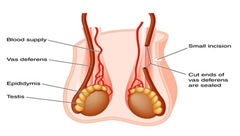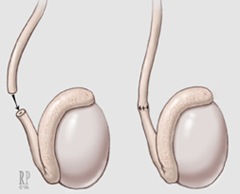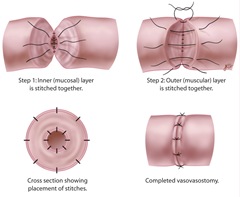Vasectomy treatment is a birth control method that prevents the body from releasing sperm along with semen during ejaculation. A surgeon will block or cut your vas deferens. This duct helps the sperm reach the urethra from the testicles. It is possible to reverse a vasectomy, but it does not always work. Hence, make up your mind about having children before opting for a vasectomy. The chances of conceiving, even after a reversal, are low.

(Source)
The sperm travels to the urethra from the testicles. So when the doctor cuts or seals the vas deferens, you will no longer ejaculate sperm. As a result, you can avoid unwanted pregnancies. Today, a vasectomy is an effective method for birth control. American Urological Associations suggests that only two out of 1000 couples get pregnant again after a vasectomy.
Effectiveness of Vasectomy
Vasectomies are 100% effective, but in some exceptions, the tubes rejoin, causing sperm to leave the body. After a vasectomy, your body doesn’t stop releasing sperm right away. You need to schedule follow-up appointments with the doctor, so they can check and ensure that you are completely sperm-free. If a vasectomy isn’t effective in providing the results you need, try opting for another birth control procedure.
Side Effects of a Vasectomy
Vasectomy is a safe procedure. However, you might experience some pain afterward. Furthermore, your scrotum might swell as well. It is quite possible that you may bleed a little, but since these side effects only occur rarely, a vasectomy procedure does not include serious complications. Only 1 to 2 percent of men will experience severe pain, which does go away that easily.
The complications are not common, but they might occur. Here are some possible side effects you might suffer after the treatment:
- Infection
- Inflammation
- Bruising
These complications can go away with time, but if you think your condition is getting worse, you should visit a doctor and discuss your symptoms. Here are some other rare side effects:
- Sperm granuloma (Inflammation or a hard lump you might develop after leaking sperm)
- Pressure, ache, and discomfort in your testicles.
- Hydrocele (This is the sac of fluid that starts to swell the scrotum.
- Spermatocele (a cyst that you might develop in the sperm collecting tube)
Is it Possible to Reverse Vasectomy
It is possible to reverse a vasectomy, but not always. Vasectomy reversal is not easy, and it won’t work for everyone. You should not consider the procedure if you are unsure about having children in the future.
But suppose you opted for a vasectomy and now you want to reverse the procedure. In that case, you can talk to the doctor about getting the reversal.
In a vasectomy, the doctor cuts the sperm-carrying tube, vas deferens. While performing a reversal, the doctor rejoins the tubes, enabling the semen to pass through the testes to the penis while ejaculating.
Methods for Vasectomy Reversal
The doctor will perform vasectomy reversal from one out of two methods. Vasovasostomy is the first treatment that the doctor will recommend. In this technique, the doctor will sew both the ends of vas deferens. By connecting the vas deferens, the penis and testes join together.

(Source)
Vasoepididymostomy is the second method your doctor might suggest. The doctor will attach the vas deferens with a small organ. This organ holds the sperm. Vasoepididymostomy is difficult and riskier than Vasovasostomy. Doctors only choose this method if a Vasovasostomy fails.
The doctor will perform the treatment in a clinic or hospital. They will provide anesthesia, so you are unconscious throughout the procedure and do not feel any pain. The procedure will take around two to four hours. However, you can go back home once the doctor performs the treatment. You will need two weeks to recover completely. You can reverse a vasectomy as many times as you want, but each time, the success rate decreases.
Preparing for Vasectomy Reversal
Here are some things that you need to know before undergoing vasectomy reversal:
- The treatment can be expensive, and your insurance policy may not cover it. You need to confirm costs before the treatment so you can arrange for the funds.
- Vasectomy reversals are highly successful when a professional surgeon performs them. You need to ensure the surgeon has extensive experience executing microsurgical techniques, especially one that includes a surgical microscope.
- The Vasoepididymostomy procedure is complex, so discuss the procedure and complications with a specialist prior to the surgery.
Conclusion
Thoroughly consult your specialist before opting for a vasectomy or vasectomy reversal. Furthermore, you can also ask about the complication and risks of the treatment. An in-depth discussion helps you determine if it’s the right procedure for you.
To learn more about these procedures, call Dr. Yaniv Larish at (646) 862-5500.



